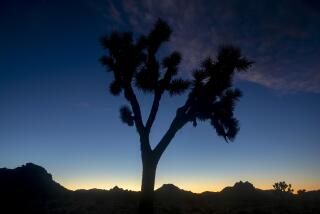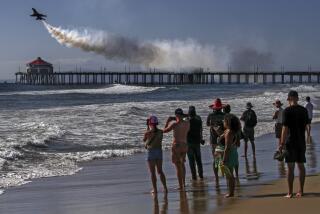The latest buzz on flying drones in state and national parks: Rules can still be vague

It was a nearly perfect day at Children’s Pool Beach in La Jolla: seals at rest in the sand, tourists gathered along the cliffs, sea gulls wheeling above. And in the middle of it all, a hovering drone.
“Wouldn’t it be great if the gulls attacked?” one bystander asked.
“Who is flying that drone?!” demanded another, voicing worries that the drone could endanger pregnant seals on the beach.
Nobody spoke up and the drone soon zoomed away, which left the rest of us to wonder: Was that expedition legal or not? The answer wasn’t immediately clear. (More on that in a moment.)
Travelers — especially drone enthusiasts — should know that public park policies vary widely when it comes to unmanned aircraft. Before you send anything aloft — or holler in protest about somebody else’s aircraft — it’s wise to do some homework.
Besides the Federal Aviation Administration’s restrictions on small unmanned aircraft (https://knowbeforeyoufly.org), many parks have their own restrictions. However, some public agencies are moving much faster than others on this subject.
If you’re headed for a national park, for instance, the answer is simple: Drones are banned until the National Park Service comes up with a long-term policy. That ban covers not only the 59 full-fledged national parks but about 350 national monuments, seashores and other sites run by the NPS, about 84 million acres in all.
The provisional ban dates to 2014 when, citing safety and noise issues, NPS Director Jon Jarvis issued a no-drones policy. The temporary ban carries a maximum penalty of a $5,000 fine and six months in jail.
NPS spokesman Jeffrey Olson said the agency will probably offer a draft administrative rule to update the policy this summer, with a final rule likely to take effect a few months later.
“Are there going to be drones in the Santa Monica Mountains or Yosemite or the big iconic parks? Probably not,” Olson said.
However, he said, “we think that there are going to be some places in the national park system where drones could be allowed.” One example: Gateway National Recreation Area in New York and New Jersey, which has been a favorite spot for model plane enthusiasts for more than a decade.
In late 2014 a tourist was fined for crashing a drone into Yellowstone National Park’s Grand Prismatic Spring. U.S. Park Police reported at least 10 unmanned aircraft incidents in the NPS areas of Washington, D.C., in 2015, including the Dec. 16 citation of a man operating a drone near the Washington Monument grounds.
“We’ve written some tickets, but far and away most of the cases are handled as an educational moment,” Olson said.
There’s no such blanket ban in California’s state parks. In fact, the state park system has no system-wide drone policy in place, California State Parks spokesman Dennis Weber said. But he noted that existing state laws would apply if a drone posed a danger to visitors or wildlife. Weber said the parks department has no statewide figures on citations or warnings associated with drones.
Individual state parks, however, have put drone restrictions in place. At Hearst Castle in San Simeon, director of marketing and communications Jim Allen said, “We do not permit the use of drones.” Allen said he was unaware of any drone citations in the last year.
Now back to Children’s Pool Beach in La Jolla, which is supervised by city of San Diego lifeguards. A spokesman for San Diego’s Lifeguard Services said the agency has no specific policy for drones and that he hadn’t heard of any particular problems with them. However, he noted, the Children’s Pool Beach is covered by federal laws stating that “you can’t harass or molest any of the seals or sea lions.”
More to Read
Sign up for The Wild
We’ll help you find the best places to hike, bike and run, as well as the perfect silent spots for meditation and yoga.
You may occasionally receive promotional content from the Los Angeles Times.







